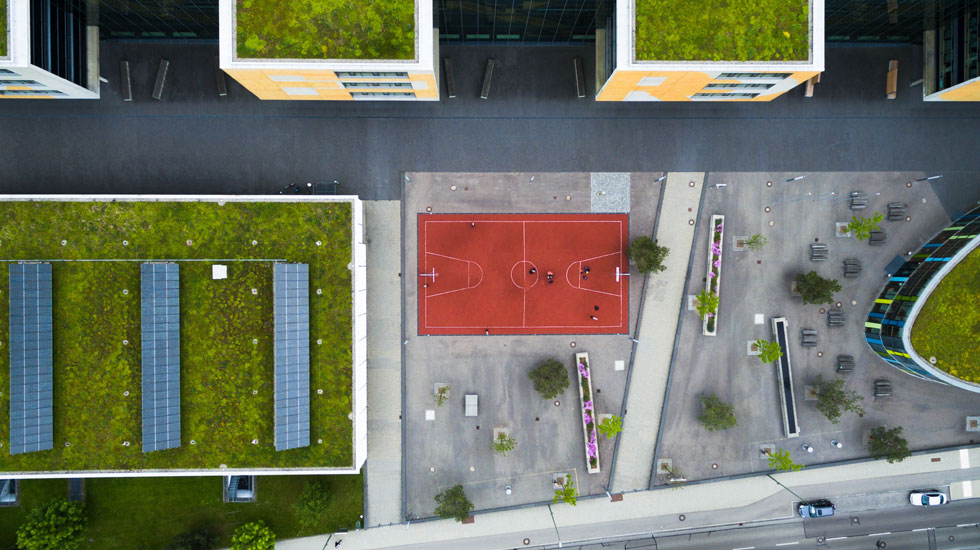In the years since LEED certifications took effect (approximately 15), much of the rationale for going green or adopting sustainability best practices has been centered on cost savings from energy, water, and other forms of conservation. The cost savings are real and valid and can add significantly to a property’s appraised value.
But appraisal is both science and art. Appraisers see buildings not only as bricks and mortar, glass and steel, where value is determined by comps, but as active hubs for tenants, visitors, and employees. Buildings house people and the people who work, play, learn, or reside within are also determinants of a building’s value.
It is not news that tenants prefer green buildings. Of course they do! What company wouldn’t prefer healthier, environmentally-friendly spaces with non-glare LED lighting, ergonomic office furniture, and more natural light, lounge areas, and green spaces? But the big question is: are tenants willing to pay the tariff for renting in a green building?
For a long time, green was rarely a crucial influence in a lease decision, with location and cost being the ever-present decision-making factors. The early reality was that green buildings were expensive, time-consuming, and difficult to build, and often very technical. But times have changed.
Where once aesthetically pleasing green architecture was considered an oxymoron, today’s architects, engineers, and constructors have embraced and become adept in green building.
Where once recycled green products were eco-ugly, cheap, and unpleasant, today’s green products have increased in supply, decreased in cost, and become eco-chic, such as those designers who are working in a higher aesthetic called sophisticated recycle.
The U.S. Green Building Council (USGBC) conducted a survey that queried Fortune 200 companies about LEED and the Corporate Built Environment, showing:
- 82 percent of survey respondents are likely to continue using LEED over the next three years for new construction or retrofit projects;
- 60 percent of surveyed companies believe LEED positively impacts their return on investment (ROI);
- 70 percent stated they pursue LEED as a means to save money by being more energy efficient;
- 80 percent agree that LEED is a key way their company communicates sustainability efforts to stakeholders.
The above may be the case for large corporations, but what of the much more numerous privately-held companies and not for profit tenants? For that answer, another study by DTZ shows that, “occupants in green certified buildings tend to be more satisfied than those in conventional buildings.” The study also found that the greater the number of certifications a building possesses, the higher the level of tenant satisfaction, especially when green practices lower costs and improve services.
One of the challenges for an appraiser is to incorporate the growing desirability of green buildings with the value of tenant happiness, increased productivity, employee retention, and wellness—variables that can be elusive, not fully understood, or easily measureable.
Have we reached a point of a meeting of the minds between property owners and tenants where owners are convinced of the economic benefits of green practices in tandem with tenants who want to generate their own benefits of greater productivity, increased employee wellness, and retention?
Certainly, we have such momentum in the marketplace. There is a growing body of study that links upgraded indoor air quality to increased worker productivity and improvement of a company’s bottom line.
A 2017 study from the Harvard T.H. Chan School of Public Health found that “working in an office with higher air quality and better ventilation can raise employees’ cognitive function scores, and that shifting to more blue-enriched light that mimics sunlight can lead to better sleep quality.” The study also concluded that “improving air quality through higher ventilation rates is estimated to cost, on average, less than $40 per person per year, and that productivity benefits from doubling ventilation rates would be roughly $6,500 per year.” You do the math.
There are also new certifications that specialize in rating healthy buildings.
WELL, from the International WELL Building Institute, currently lists 734 projects totaling over 139 million square feet that are applying WELL concepts to helping people work better, smarter, and more productively.
The Fitwel certification system supports individual and community health through improvements to building design and operations. Created by the U.S. Centers for Disease Control and Prevention (CDC) with the General Services Administration (GSA), Fitwel currently has 380 projects either certified or in progress, and 600 projects committed through 2018.
With huge strides being made in certifications and the body of knowledge focused on building and tenant health, we are better able to understand and document the many advantages of owning and/or occupying a green building.
Will having a healthy, high-performance building increasingly enter into tenant decisions about leasing space? Absolutely. It may soon become the third important deal-maker or breaker in commercial property decisions.
Steven J. Schleider, MAI, FRICS, LEED AP BD + C,
President, Metropolitan Valuation Services
44 East 32nd Street
New York, NY 10016
212-213-8650
sschleider@MVSappraisal.com
www.MVSappraisal.com





















Add Comment